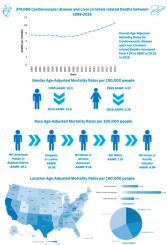Demographic and regional trends of mortality in patients with cardiovascular disease and liver cirrhosis in the United States between 1999 and 2019
IF 2.1
Q3 PERIPHERAL VASCULAR DISEASE
引用次数: 0
Abstract
Objectives
National estimates of deaths related to cardiovascular disease (CVD) and liver cirrhosis remain ambiguous. The purpose of this study was to observe the contemporary trends in CVD and liver cirrhosis-related mortality in the United States.
Methods
We evaluated the trends using the CDC WONDER database to identify adults with CVD and liver cirrhosis associated death between 1999 and 2019. Age-adjusted mortality rates (AAMRs) per 100,000 population and associated average annual percent changes (AAPCs) with 95 % confidence intervals (CIs) were assessed using Joinpoint regression.
Results
Between 1999 and 2019, a total of 374,090 deaths occurred due to CVD and liver cirrhosis. In the overall population, the AAMR increased from 7.54 (95 % CI 7.41–7.67) in 1999 to 10.55 (95 % CI 10.43–10.68) with an AAPC of 1.68 (95 % CI 1.59–1.77). The highest AAMRs were seen in males, Native Americans, and those living in West. A substantial increase in AAMRs was observed in all age groups with the highest seen in 70–84 year group. Moreover, non-metropolitan cities had a much higher increase in AAMRs compared to large metropolitan cities. The highest AAMRs were observed in California whereas the lowest in Utah.
Conclusion
There is a rising trend of CVD and liver cirrhosis-associated mortality in all groups. However, disparities continue to exist in association with gender, race, age, and geographical region. Future trials should address alleviating CVD and liver cirrhosis-related deaths in all population groups equitably.

1999年至2019年美国心血管疾病和肝硬化患者死亡率的人口统计学和区域趋势
目的:国家对心血管疾病(CVD)和肝硬化相关死亡的估计仍不明确。本研究的目的是观察美国心血管疾病和肝硬化相关死亡率的当代趋势。方法:我们使用CDC WONDER数据库评估1999年至2019年期间心血管疾病和肝硬化相关死亡的趋势。使用Joinpoint回归评估每10万人的年龄调整死亡率(AAMRs)和相关的年平均百分比变化(AAPCs), 95%置信区间(ci)。结果1999年至2019年,共有374090人死于心血管疾病和肝硬化。在总体人群中,AAMR从1999年的7.54 (95% CI 7.41 ~ 7.67)增加到10.55 (95% CI 10.43 ~ 10.68), AAPC为1.68 (95% CI 1.59 ~ 1.77)。男性、美洲原住民和居住在西部的人的aamr最高。在所有年龄组中均观察到AAMRs的显著增加,其中70-84岁组最高。此外,与大城市相比,非大城市的aamr增幅要高得多。aamr最高的是加利福尼亚州,最低的是犹他州。结论各年龄组CVD及肝硬化相关死亡率均有上升趋势。然而,与性别、种族、年龄和地理区域相关的差异仍然存在。未来的试验应在所有人群中公平地减轻心血管疾病和肝硬化相关死亡。
本文章由计算机程序翻译,如有差异,请以英文原文为准。
求助全文
约1分钟内获得全文
求助全文
来源期刊

Atherosclerosis plus
Cardiology and Cardiovascular Medicine
CiteScore
2.60
自引率
0.00%
发文量
0
审稿时长
66 days
 求助内容:
求助内容: 应助结果提醒方式:
应助结果提醒方式:


